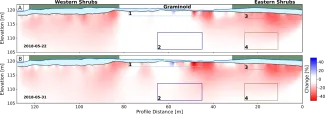Climate change is causing rapid changes of Arctic ecosystems. YetHowever, data needed to unravel complex subsurface processes are very rare. Using geophysical and in situ sensing, scientists working on the NGEE Arctic project helped bridge an observational gap associated with thermohydrological dynamics in discontinuous permafrost systems. Monitoring for more than 2 years, the team gathered data gathered at a field site near Nome, AlaskaK to highlight the impact of vegetation, topography, and snow thickness distribution on subsurface thermohydrological properties and processes. These researchers observed that large snow accumulation near tall shrubs insulates the ground and allows for rapid and downward heat flow (Fig. 6). Thinner snowpack above the graminoid results in surficial freezing and prevents water from infiltrating into the subsurface. Analyzing short-term disturbances such as snowmelt or heavy rainfall, it wasthe team found that lateral flow could be a driving factor in Talik formation. Interannual measurements showed that deep permafrost temperatures increased by about 0.2°C over 2 years. The results, which suggest that snow-vegetation-subsurface processes are tightly coupled, will be useful for improving predictions of Arctic feedback to climate change, including how subsurface thermohydrology influences CO2 and CH4 fluxes
For more information, please contact:
Sebastian Uhlemann
suhlemann@lbl.gov

